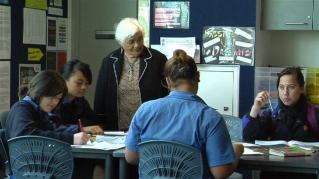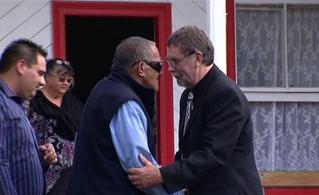Section navigation
Introduction
Background
Te Mana Kōrero Online has been developed to help school leaders and teachers address and meet the goals of Ka Hikitia: Managing for Success: The Māori Education Strategy 2008–2012 (Ministry of Education, 2008-2009). It is based on information in the Te Mana Kōrero resources and other successful initiatives, and it provides tools for using an inquiry approach to investigate six key themes that affect Māori student achievement in schools.
Identifying the issues
All schools need to address the challenge of realising the potential of Māori student engagement and achievement. At all levels of schooling, Māori students appear to be disengaging from learning and consequently underachieving in relation to the expectations established by The New Zealand Curriculum (Ministry of Education, 2007) and related documents. For example, data cited in Ka Hikitia: Key Evidence and How We Must Use It to Improve System Performance for Māori (Ministry of Education, 2008) indicates that:
- “By the end of year 1, literacy achievement for many Māori children is lower than for any other ethnic group, even where the starting point was similar” (p. 17)
- “About 15 percent of Māori youth leave school before their 15th birthday … In year 9, Māori students make up more than 50 percent of early leavers” (p. 27)
- “In 2006, 43 percent of Māori students left school before they got any qualifications” (p. 28).
Professor Russell Bishop said, in the first two Te Mana Kōrero resources (2004 and 2005), “[W]e’re risking turning out 40% Māori with no formal qualifications whatsoever. What we’re risking in schools and what we’re risking as a society is too scary to contemplate.”
National data since 2004 shows that this position does not seem to have significantly changed. Indeed, Bishop declares, in his introduction to the best evidence synthesis Teacher Professional Learning and Development: Best Evidence Synthesis Iteration, that “[O]ur number one educational issue … [is] the educational crisis that faces Māori people” (Timperley, Wilson, Barrar, & Fung, 2007, p. xix).
Addressing the issues
It is neither necessary nor inevitable that Māori students should disengage from learning and underachieve. Professional development initiatives around the country appear to have led to Māori achievement levels that are close to the national norm. For example, evidence from the Numeracy Development Projects 2000–2008 indicated that the average effect size growth for the Māori students affected was 0.35 compared to the average effect size growth of 0.33 for Pākehā learners. Literacy initiatives in South Auckland and the Waikato in the same period led to Māori student achievement levels that were within or close to the national average band (Ka Hikitia: Key Evidence, p. 18).
Working with Ka Hikitia: Managing for Success
The Ministry of Education believes that all Māori learners have unlimited potential, all Māori have cultural advantage by virtue of who they are, and all Māori are inherently capable of achieving success. The Ministry’s comprehensive strategic plan – Ka Hikitia: Managing for Success – is based on those beliefs. This plan outlines a way forward that will enable our schools to realise Māori potential for learning and achievement. The Ministry describes the plan as “a collective call to action … [that] requires everyone in the education system to take responsibility for Māori education success, alongside whānau and iwi” (Ka Hikitia: Managing for Success, p. 11).
Ka Hikitia: Managing for Success is about “Māori enjoying education success as Māori”. As such, it represents a move away from a focus on “deficit, problems, failure and risks”, to a focus on “making the most of opportunities for success” (ibid., p. 11).
The plan’s four broad outcomes for students (on page 15) are that Māori students will be able to:
- work with others to determine successful learning and education pathways
- excel and successfully realise their culture distinctiveness and potential
- successfully participate in and contribute to te ao Māori
- gain the universal skills and knowledge needed to successfully participate in and contribute to Aotearoa New Zealand and the world.
Ka Hikitia: Managing for Success focuses on four particular areas or contexts, because research has shown that these contexts are critical ones (points of vulnerability) for Māori students during their schooling. The plan aims to promote students’ engagement and achievement especially:
- in the foundation years of learning
- during adolescence (“young people engaged in learning”, particularly in years 9 and 10)
- through Māori language in education.
It also aims to focus on:
- ways of enhancing sector organisation to enable Māori students to enjoy success as Māori.
Ka Hikitia: Managing for Success is underpinned by the following five premises (see the bottom of pp 14–15 of that document).
- All educators need a high level of professional capability for working effectively with Māori students.
- Sector leadership (especially school leadership) needs to be responsive and accountable for Māori student outcomes.
- Family, whānau, and iwi need to be fully engaged in the learning of their tamariki.
- Students need access to high-quality Māori-language education.
- All branches of the education sector (including government agencies) need to work together to ensure change for Māori students.
This means, for example, increased professional learning for teachers, a stronger focus on responsive and accountable professional school leadership, and greater whānau, hapū, and iwi involvement in education. The plan outlines actions to take to meet these needs.
Working with supporting materials
Over the past ten years, a range of professional development projects and resources have been developed to help school leaders and teachers explore ways to realise the potential of Māori students. These include Te Mana Kōrero, Te Kotahitanga, He Kakano, Te Kauhua, and the Taihape Area School Case Study.
Te Mana Kōrero
This series of professional development packages has been separated into 7 sections:
- Introduction
- Undertaking professional development on issues related to Māori students’ engagement and achievement
- Having high expectations for Māori students’ achievement
- Engaging Māori students meaningfully in all aspects of learning
- Developing responsive and respectful relationships with Māori students
- Building, maintaining, and using responsive and respectful partnerships
- Building responsive school leadership in order to realise Māori students’ potential
These themes have been developed based on the original offline resources (including DVDs) of:
- Te Mana Kōrero 1 –Teachers Making a Difference
- Te Mana Kōrero 2 – Strengthening Professional Practice
- Te Mana Kōrero 3 – Relationships for Learning.
It is designed to help school leaders and teachers reflect on and make changes to:
- their expectations for achievement by Māori students
- the nature, quality, and cultural responsiveness of the instructional strategies they use when interacting with Māori students
- the level and effectiveness of school-whānau-iwi interactions within their school community.
Online materials are available at http://tetereauraki.tki.org.nz/Te-Mana-Korero
Te Kotahitanga
This professional learning project is designed to help school leaders and teachers explore classroom practices that might enhance Māori student engagement and achievement, especially among year 9 and 10 students in mainstream classrooms. This means exploring and implementing a research-based “Effective Teacher Profile”, a tool with a focus on developing culturally responsive teacher-learner interactions and on designing classrooms to enhance student achievement.
Online materials (including video footage of Te Kotahitanga facilitators, teachers, and students discussing the project and its impact on student engagement and achievement) are available at: http://tekotahitanga.tki.org.nz
He Kakano
This professional learning project is designed to help secondary school leaders build culturally responsive leadership and teacher practices that have been developed to enhance Māori learner engagement and achievement. Elements of change that school leaders explore through the initiative relate to: goal setting; culturally responsive relationships; pedagogic leadership; distributed leadership; evidence-based decision making; institutional reform; and ways of working closely with whānau and iwi and using their aspirations and practices.
Online materials (including video footage of He Kakano facilitators, teachers, and students discussing the project and its impact on student engagement and achievement) are available at: http://hekakano.tki.org.nz
Te Kauhua
In this professional learning project (linked to Te Kotahitanga), school leaders and teachers inquire into the nature and effectiveness of particular actions they undertake to improve teaching and learning for Māori students and enhance the quality of school-whānau-iwi interactions. Participants have reported on the outcomes of their inquiry, particularly on changes they have made to improve teaching and learning and to enhance school-whānau-iwi interactions.
Other resources, including the Taihape Area School Case Study
A number of agencies have developed electronic and/or hard-copy case studies, illustrations, and reports of effective practice designed to realise Māori student engagement and achievement potential. These resources include a range of New Zealand Curriculum Online case studies (sponsored by the Ministry of Education), which feature schools with a significant proportion of Māori students, as well as research reports published by the New Zealand Council for Educational Research and the Education Review Office. The Taihape Area School Case Study is particularly useful. It explores changes that have impacted significantly and positively on Māori student engagement and achievement. This case study can be found at: https://nzcurriculum.tki.org.nz/Curriculum-resources/Media-gallery/School-curriculum/Putting-students-first
The overall intent of Ka Hikitia and related programmes and documents
Former secondary principal Chris Day observed, in an address to He Kakano school leaders: “The strategic intent is Māori enjoying education success as Māori, which is what we all want, and of course … Ka Hikitia or He Kakano [are] not seeking special responses, but rather a professional and ethical one to address those inequalities in Māori student achievement across the country.”
A number of common themes or threads run across these projects and resources. For example, some include a thread about helping school leaders and teachers to reflect on their beliefs about Māori student potential; some include a thread about exploring specific pedagogical research-based actions that enhance Māori student achievement; and some include a thread about focusing on ways of strengthening school-whānau-iwi interactions.
With the publication of the Ministry of Education’s Māori Education Strategy 2008–2012 (Ka Hikitia: Managing for Success), it is timely that the common themes be identified and main ideas in each theme be brought together. Exploring these themes, particularly by using an inquiry approach, will help schools address and meet the goals of Ka Hikitia: Managing for Success, especially the four broad outcomes for students.
The purpose of Te Mana Kōrero Online
Te Mana Kōrero Online has been developed to help school leaders and teachers address and meet the goals of Ka Hikitia: Managing for Success. Its major aims reflect this purpose. The website aims to enable school leaders and teachers to:
- identify the themes that weave across the professional development initiatives and resources described above, particularly Te Mana Kōrero 1, 2, and 3 and the Taihape Area School Case Study
- understand the research-based concepts (theoretical understandings) that underly all of the themes
- make links between their current beliefs, understandings, and actions and the beliefs, understandings, and actions suggested within the initiatives and resources. Te Mana Kōrero Online recommends that school leaders and teachers adopt an inquiry approach to help them make these links and decide on changes to make to their own beliefs, understandings, and practices.
What’s in Te Mana Kōrero Online?
The introduction to Te Mana Kōrero Online explains the background and the need for such a resource and describes its purpose and content. The following sections describe the concepts that underly the resource, identify the themes, and describe the recommended inquiry approach.
The main body of Te Mana Kōrero Online unpacks each theme in detail. For each theme, this resource suggests questions to focus professional development, identifies key research evidence, and offers ways of exploring the relevant supporting materials.


